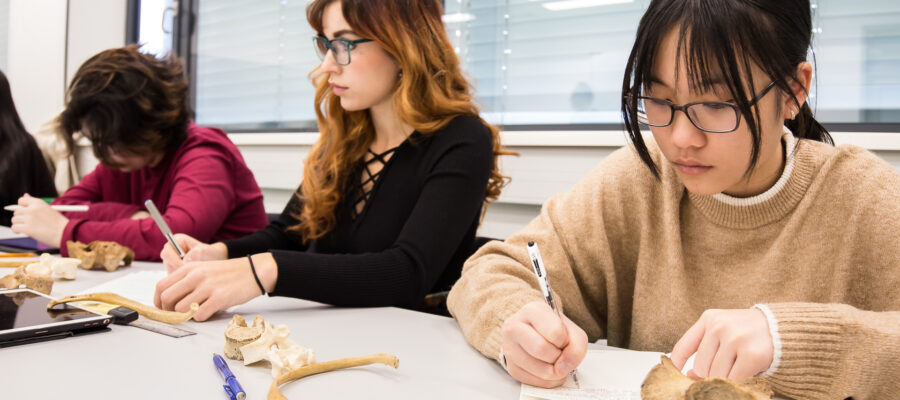I. GENERAL AND INORGANIC CHEMISTRY
Atoms and molecules. Definition of atom. Atomic number. Mass number. Protons and neutrons. Electrons. Electron configurations. Isotopes. Isotones. Radioactivity. Radioactive decay. Atomic, molecular and molar mass. Relative atomic or molecular mass. Dalton. – Molar mass and amount of a substance. Avogadro´s constant. Units. – Chemical bonds: Strong bonds – covalent bond, ionic bond, metallic bond. Weak bonds – hydrogen bridges, Van der Waals Forces, hydrophobic interactions. Intermolecular forces in solids, liquids and gases.
The periodic table of elements. Arrangement. Rows. Columns. Electron configuration of elements. Symbols of elements. Periodic properties of elements. Stoichiometry. – Group I.A (1) elements. Hydrogen and alkali metals (lithium (Li), sodium (Na), potassium (K), rubidium (Rb), caesium (Cs, francium (Fr)). Valence electrons. Isotopes of hydrogen. The role of sodium and potassium in the body fluids. – Group II.A (2) elements. The alkaline-earth metals. Beryllium (Be), magnesium (Mg), calcium (Ca), strontium (Sr), barium (Ba), radium (Ra). Valence electrons. The role of magnesium and calcium in the human body. – Group III.A (13) elements. Boron (B), aluminium (Al), gallium (Ga), indium (In), thallium (Tl). Valence electrons. Occurrence of Al on earth. – Group IV.A (14) elements. Carbon (C), silicon (Si), germanium (Ge), tin (Sn), lead (Pb). Valence electrons. Importance of C for living organisms. Carbon oxides. – Group V.A (15) elements. Nitrogen family. Nitrogen (N), phosphorus (P), arsenic (As), antimony (Sb), bismuth (Bi). Valence electrons. Abundance of nitrogen in the atmosphere. Ammonia. Nitrogen oxides. – Group VI.A (16) elements. Chalcogens. Oxygen (O), sulphur (S), selenium (Se), tellurium (Te), polonium (Po). Valence electrons. Abundance of oxygen in the Earth’s crust, in the atmosphere. Oxidation of nutrients to gain energy. Oxides. Water. Sulphides, sulfuric acid, sulphates. – Group VII.A (17) elements. Halogens. Fluorine (F), chlorine (Cl), bromine (Br), iodine (I), and astatine (At). Valence electrons. Halide anions. Sodium chloride. Importance of fluoride and iodide intake for health. – Group VIII.A (18) elements. Noble gases. Helium (He), neon (Ne), argon (Ar), krypton (Kr), xenon (Xe), and the radioactive radon (Rn). Reactivity. Electron shell. Occurrence in air.
Nomenclature of inorganic compounds. Oxides. Hydroxides. Inorganic acids. Halides. Sulphides. Cyanides. Nitrates. Sulphates. Hydrogen carbonates. Phosphates. Hydrides. Stoichiometric calculations. Oxidation states.
Mixtures. Homogenous mixtures: solutions. Dissolved substance and solvent. Solubility. – Mass fraction, molarity, mass concentration, calculations. – Solutions of nonelectrolytes and electrolytes, dissociation, calculations. – Heterogeneous mixtures: suspensions, emulsions. Sedimentation. Stability. – Density, mass, volume: calculations, units.
Chemical reactions. Synthesis. Decomposition. Single replacement (displacement). Double replacement (partner-exchange). Condensation. Hydrolysis. Impact of temperature, concentration of reactants and presence of catalysts on the rate of chemical reaction. Equilibrium constant. – Oxidation and reduction. Transfer of electrons. Redox pair. Oxidizing and reducing agents. Balancing chemical equations. – Protolytic reactions. Acids, bases, amphoteric compounds. Concentration of hydrogen ions, pH concept. Strong and weak acids, pH calculation. Neutralization (titration), calculations. Dissociation constant.
II. ORGANIC CHEMISTRY AND BIOCHEMISTRY
General structure, nomenclature, molecular, empirical, structure formulas, and reactions of organic compounds. – Important terms in organic chemistry: Valence of C, H, O, N, halogens, saturated and unsaturated hydrocarbons, aliphatic and aromatic hydrocarbons, single and multiple bonds, isomers, common halogen derivatives. – Thiols, alcohols, phenols, aldehydes, ketones, and quinones. –Carboxylic acids: mono-, di- and tricarboxylic acids and their derivatives: salts, esters, amides, anhydrides, halides, and nitriles. Fatty acids. – Heterocyclic derivatives: furan, imidazole, indole, purine, pyridine, pyrimidine, pyran, pyrrole. – Amines: nomenclature, structure, classification: primary, secondary, tertiary amines, choline, epinephrine, norepinephrine, dopamine, serotonin, and histamine. – Amino acids: formulas, classification, properties, reactions. – Saccharides: structure, properties, D- and L- enantiomers, reactivity, the most important mono-, di- and polysaccharides. – Lipids: triacylglycerols, phospholipids, steroids. Cholesterol, lecithin, sphingomyelin. – Proteins: structure, properties and function. Primary, secondary, tertiary, and quaternary structure. – Nucleic acids: structure, components, purine and pyrimidine bases, nucleosides, nucleotides, complementary base pairing, bonds in nucleic acids. DNA and RNA, types of RNA. – Vitamins.


